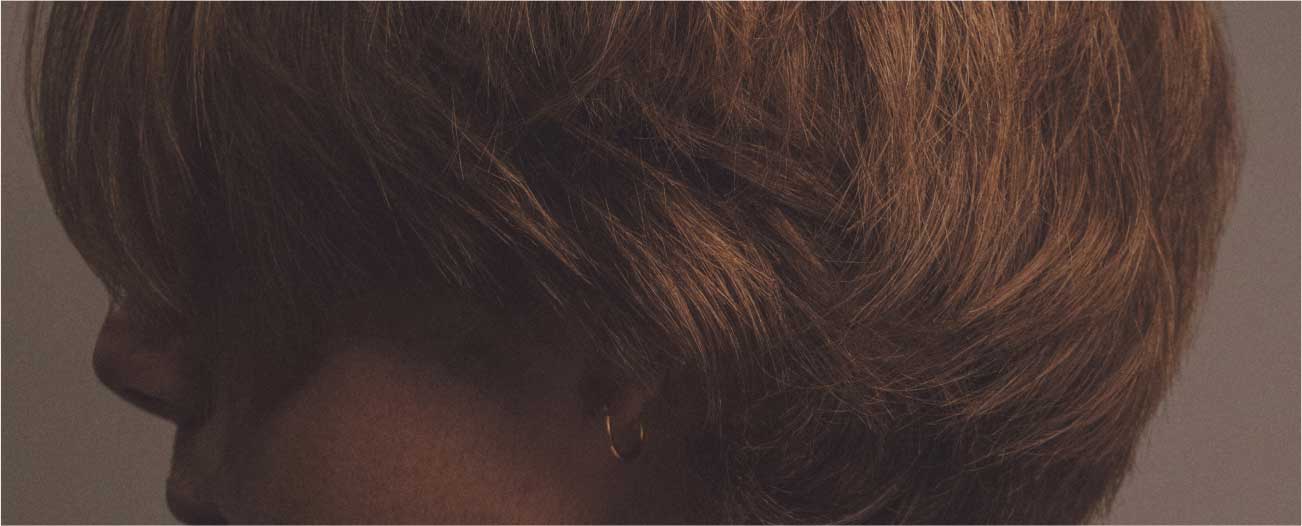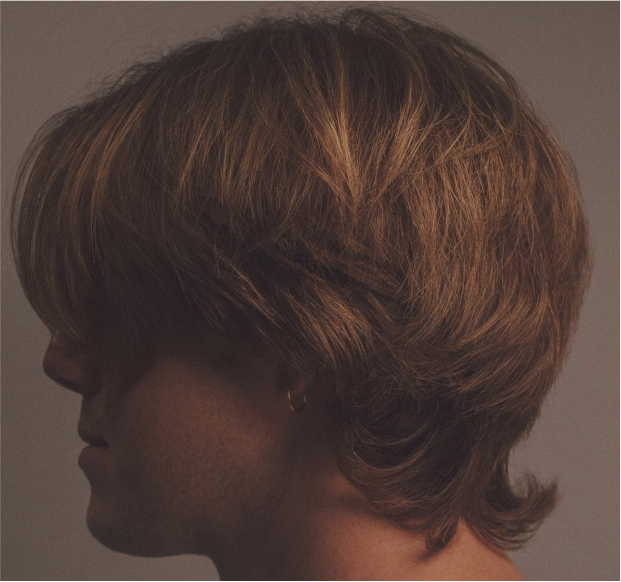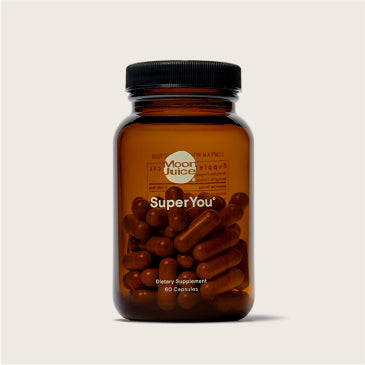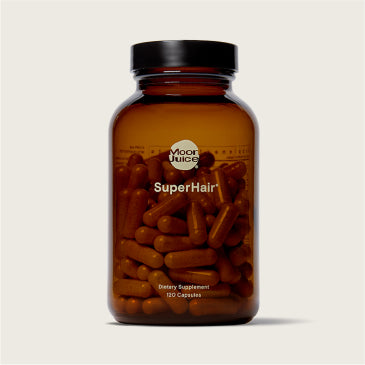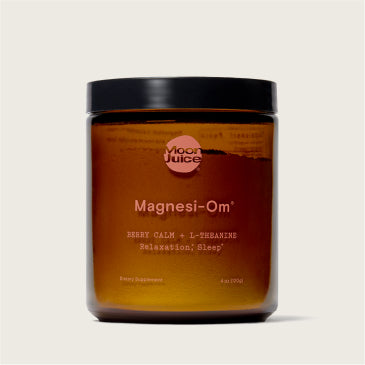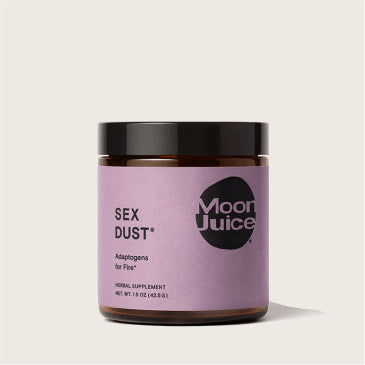Hair that tends toward the thin side is perfectly natural, but rapid changes like thinning hair can be an alarming sign of imbalance in the body. Our hair is an outward sign of inner health, so if you’re starting to lose some fullness or just want to encourage more growth, you're probably wondering how to fix thin hair. The good news is that there are some changes you can make or new habits you can incorporate into your lifestyle to combat hair thinning and encourage hair regrowth.
What causes thin hair and its challenges
The first thing to know is that fine hair, thin hair, and thinning hair all refer to different things. Fine hair refers to the thickness of your hair strand. So you could have plenty of fine hair, or thin hair where the strands are coarse.
Thinning hair is when you’re starting to notice less hair or a decrease in hair thickness, whether due to slowed growth, excessive hair shed, or a combination of the two. Here’s how it works. There are three main phases to your hair cycle: the growth phase (anagen), the rest phase (catagen), and the fall-out phase (telogen).
All the hairs on your head are in different phases of these cycles, but chronic stress can push your hair to enter the telogen cycle too soon.
Hair Loss vs Hair Shedding
It’s also important to understand the difference between hair loss and hair shedding, which are not the same.
- Hair loss (anagen effluvium) occurs when your follicles stop growing hair. We all have about 100,000 follicles on our head, and we’re never going to gain or lose them throughout our lives, but the growth of hair out of these follicles can decline for a number of reasons.
Hair shedding (telogen effluvium), on the other hand, is when hair falls out more rapidly than it should, because it’s being kicked into the resting phase of its life cycle too soon.
While it’s normal to lose between 50 to 100 hairs daily, according to the American Academy of Dermatology (AAD), anything over that could signal what’s considered thinning hair. If you’re having to snake the drain a lot, or notice more hair on your pillow, in the shower, or on your brush than usual, it could be time to take some active measures. Another way to test is the 60-second method. Flip your hair over and comb it for 60 seconds. If you collect more than 10-20 strands, you are likely experiencing excessive hair shedding.
Thinning hair is complicated, and there are many different reasons people experience it, from dietary to hormonal imbalances. However, there are certain ways to address it and habits to adopt that encourage healthy hair growth.
Dietary changes to combat thinning hair
Your hair relies on protein, healthy fats, and micronutrients in order to grow. Key minerals and vitamins that improve hair health include the following:
- Zinc
- Iron
- Vitamin A
- Biotin and other B vitamins
- Vitamin C
- Vitamin D
- Vitamin E
To support your hair’s growth and internal structure, you should give it the building blocks it needs by eating a range of whole foods like almonds, avocados, sweet potatoes, coconut, blueberries, sunflower seeds, pumpkin seeds, and high quality sources of protein.
That being said, the nutrients we receive from food often aren’t enough to grow healthy hair, because our hair is the last place key nutrients will go — essential processes like metabolism, bone growth, and cellular repair take priority.
It’s also important to note that diet alone isn’t always responsible for nutrient deficiencies — over time, keratin and melanin levels decrease, causing hair to become frizzier, drier, and more prone to breakage.
Replenishing nutrients with a multivitamin can help prevent further damage. If you’re wanting to address nutritional deficiencies, it’s a good idea to add hair supplements into your routine. SuperHair® is a comprehensive vegan multivitamin with adaptogens, botanicals, and micronutrients for hair health.* 10 bioavailable vitamins address the nutritional deficiencies that inhibit the growth of healthy hair.* Adaptogens like Ashwagandha help balance stress hormones that can contribute to thinning and hair loss.* Botanicals like Saw Palmetto support healthy hair follicles and promote thickness, and micronutrients promote hair strength and smooth texture.*
Hair care habits to improve hair texture
Hair health takes time to materialize, and it’s all about consistent habits. In addition to a balanced diet and supplementation, here are some other key hair care habits for improving the health and appearance of thin hair.
Styling
Some added texture may also be required to achieve a fuller look in thin hair. Using a hair product like a mousse can give your hair lift at the root, while a sea salt spray can help add some natural texturizing grip to hair and can enhance natural waves to make hair appear fuller. A regular haircut with some shaping can help create dimension in thin hair to make it appear thicker.
Scalp health
Ultimately, scalp health is of the utmost importance for improving the health of your hair and encouraging healthy hair growth. Hair thinning from pattern baldness has been linked to starved blood flow to the follicles, so be sure to increase circulation to your scalp. A gentle scalp massager can draw blood to your scalp to create a hospitable environment for growth. Avoid wearing a hat too often so you can allow your scalp to breathe. For more tips, learn how to improve scalp health.
Washing
How often you wash your hair can also play a role in how it feels and it will oftentimes depend on your hair type. Thin hair likely needs to be washed more often than thick hair to prevent it from appearing limp and weighed down, but it’s still best to go a few days in between washes to promote balanced hair.
Be sure to wash using gentle, pH-balanced products that won’t strip the natural moisture from your hair and scalp. Don’t use water that’s too hot and make sure all the shampoo is washed away from your skin to avoid irritation, which can cause further hair shedding if your scalp becomes inflamed.
Red Light
Red light therapy in the form of wearables is becoming increasingly common as a treatment to stimulate hair growth, and studies back this up. When a visible red light laser is applied to the scalp at the optimal intensity and duration, your body harnesses this energy and potentially uses it to regrow hair.
Sign Up, Nerd Out
Get wellness tips, education, and recipes
delivered straight to your inbox.
Get wellness tips, education,
and recipes delivered
straight to your inbox.
Natural remedies for promoting hair health
In addition to these hair-healthy habits, there are also some at-home remedies you can use to support your hair using natural ingredients. For some extra love, use a scalp mask, hair mask, or scalp spray once every 1 to 2 weeks to condition strands and help balance pH.
Apple Cider Vinegar
The antifungal and pH-balancing properties of ACV are great for your scalp. A spray or soak made of apple cider vinegar and water can help prevent dandruff and buildup that stifles hair growth.
Rosemary Oil
Rosemary oil has been found to be as effective as minoxidil after six months of use in treating hair loss, according to a 2015 trial on people with androgenetic alopecia.
Avocados
With healthy fats, B Vitamins, Folic Acid, and Vitamin E, those ripe avos you need to use go great in a weekly hair or scalp mask. Blend with high quality, cold processed and unrefined oil such as olive oil and create a past for your hair.
Peppermint Oil
The menthol in peppermint oil, as a vasodilator, can also help open blood vessels to stimulate blood flow up top. Just avoid experimenting with these homemade remedies if your scalp is sensitive or inflamed, such as when you’ve just worked out.
Enjoying longer, fuller hair
While the causes of thinning hair can vary, what you can control about your hair and scalp health remains constant. Be sure to eat a whole foods diet rich in healthy fats, quality protein, and micronutrients for hair health. Because our diets can’t be perfect all the time, supplement with a hair-healthy vitamin and include adaptogens to help your body’s internal stress response come back to the center. Texturizing products can otherwise flat and dull hair to enjoy some grip and lift, making it easier to style whether in a ponytail or left down.
Use gentle products on your scalp, and always take it easy on your hair when brushing, styling, and sleeping. Though we can’t increase the number of follicles on our head, we can help preserve and thicken the hair we do have and create a healthy environment for new growth.
Sources
- Guo EL, Katta R. Diet and hair loss: effects of nutrient deficiency and supplement use. Dermatol Pract Concept. 2017 Jan 31;7(1):1-10. doi: 10.5826/dpc.0701a01. PMID: 28243487; PMCID: PMC5315033.
- Kim, S., Kim, S.N., An, S., Yeon, J.H., Wang, X.M., Li, L., Lai, W., Liang, H., Gao, X.H., Liu, W., Park, W.S. and Na, Y. (2017) Ageing-Related Features of Hair and Scalp in Chinese Women by Clinical Evaluation Study. Journal of Cosmetics, Dermatological Sciences and Applications, 7, 245-257. https://doi.org/10.4236/jcdsa.2017.73023
- Lanzafame RJ, Blanche RR, Bodian AB, Chiacchierini RP, Fernandez-Obregon A, Kazmirek ER. The growth of human scalp hair mediated by visible red light laser and LED sources in males. Lasers Surg Med. 2013 Oct;45(8):487-95. doi: 10.1002/lsm.22173. Erratum in: Lasers Surg Med. 2014 Apr;46(4):373. PMID: 24078483.
- Panahi Y, Taghizadeh M, Marzony ET, Sahebkar A. Rosemary oil vs minoxidil 2% for the treatment of androgenetic alopecia: a randomized comparative trial. Skinmed. 2015 Jan-Feb;13(1):15-21. PMID: 25842469.
- Polak-Witka K, Rudnicka L, Blume-Peytavi U, Vogt A. The role of the microbiome in scalp hair follicle biology and disease. Exp Dermatol. 2020 Mar;29(3):286-294. doi: 10.1111/exd.13935. Epub 2019 May 15. PMID: 30974503.
- Saxena, R., Mittal, P., Clavaud, C. et al. Longitudinal study of the scalp microbiome suggests coconut oil to enrich healthy scalp commensals. Sci Rep 11, 7220 (2021). https://doi.org/10.1038/s41598-021-86454-1
- Trueb, R.M., The impact of oxidative stress on hair. International Journal of Cosmetic Science, 2015, 37 (Suppl. 2), 25–30. Available from: https://onlinelibrary.wiley.com/doi/pdf/10.1111/ics.12286
- Yang K, Tang Y, Ma Y, Liu Q, Huang Y, Zhang Y, Shi X, Zhang L, Zhang Y, Wang J, Zhu Y, Liu W, Tan Y, Lin J, Wu W. Hair Growth Promoting Effects of 650 nm Red Light Stimulation on Human Hair Follicles and Study of Its Mechanisms via RNA Sequencing Transcriptome Analysis. Ann Dermatol. 2021 Dec;33(6):553-561. doi: 10.5021/ad.2021.33.6.553. Epub 2021 Nov 4. PMID: 34858007; PMCID: PMC8577899.

